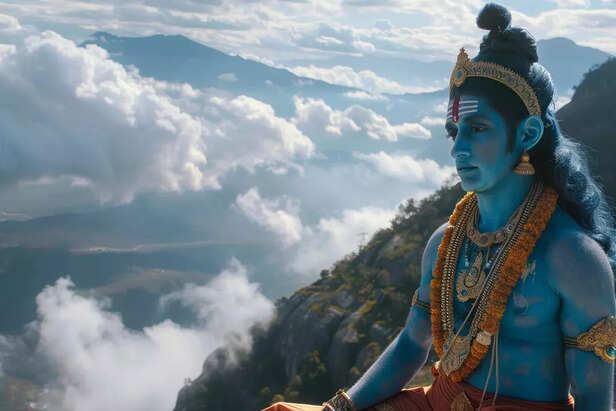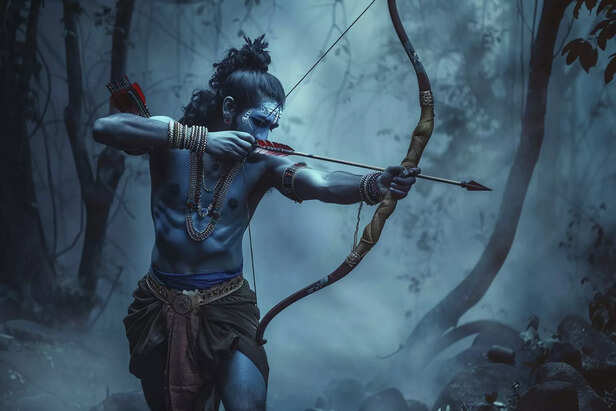Struggling in Life? Vishnu’s 10 Avatars Reveal the Wisdom You Need Now
Pranav P | Mon, 28 Apr 2025
Vishnu’s 10 avatars, known as the Dashavatara, aren’t just ancient myths — they’re packed with lessons that still resonate today. From facing life’s toughest challenges with courage to embracing humility and protecting the planet, each avatar has something valuable to teach us. In this article, we break down these powerful stories and show how their timeless wisdom can help guide us through the ups and downs of modern life.

( Image credit : Freepik )
Photo:
If you’ve ever encountered the Dashavatara — the ten incarnations of the Hindu god Vishnu — you might know that these stories aren’t just ancient myths. They’re profound lessons that resonate deeply with us today. From navigating life’s floods to standing up against injustice, these avatars are more relevant than ever in our fast-paced, ever-changing world.
In this article, we’ll explore the Dashavatara and how each of Vishnu's ten avatars offers timeless wisdom that speaks directly to modern-day challenges.

In Hinduism, Vishnu is known as the “Preserver” — the divine force that maintains balance in the universe. When things go awry, Vishnu incarnates in a new form, or avatar, to restore harmony. Each of these ten avatars was born in response to a particular crisis in the world, acting as a divine intervention to correct the course of humanity.
The Dashavatara (which literally means "ten avatars") serves as a roadmap for understanding how to navigate life's challenges with resilience, wisdom, and compassion. But here’s the twist — while these avatars belong to ancient mythology, their lessons remain incredibly relevant today.
The first avatar, Matsya, takes the form of a giant fish. This avatar appeared during a catastrophic flood that threatened to submerge all life on Earth. Matsya guided the sage Manu’s boat, preserving the sacred Vedas and ensuring the survival of wisdom through the deluge.
Modern Relevance: In our world, we face floods of challenges — from climate change to information overload. Matsya teaches us the importance of being adaptable, finding new ways to preserve knowledge, and ensuring that what truly matters survives even through difficult times.
In the same way Matsya navigated the floods, we too must learn to navigate the turbulent waters of modern life with patience and foresight.
In the second avatar, Kurma, Vishnu incarnates as a tortoise. During the cosmic churning of the ocean (known as Samudra Manthan), Kurma supports Mount Mandara on his back to prevent it from sinking, enabling the gods and demons to extract the nectar of immortality.
Modern Relevance: In today’s world, we’re often overwhelmed by the rapid pace of life. Kurma teaches us that true strength often lies in quiet endurance. We may not always be the loudest or the fastest, but we can be the steady support that helps others through their struggles.
Whether in friendships, family life, or work, Kurma’s wisdom shows us the power of being a calm, reliable presence in the midst of chaos.
The third avatar, Varaha, manifests as a boar who dives into the cosmic ocean to rescue Earth, which had been submerged by the demon Hiranyaksha. Varaha lifts the Earth on his tusks and restores balance to the world.
Modern Relevance: Varaha’s story is a reminder of the urgent need for environmental responsibility. In an age of pollution, deforestation, and climate change, Varaha’s courage to dive deep and lift the Earth out of harm’s way inspires us to take bold action to restore the planet’s balance.
Just like Varaha, we must tackle global issues head-on with determination and strength to protect our environment for future generations.
In the form of a half-man, half-lion, Narasimha appeared to save his devotee Prahlada from his tyrannical father, the demon king Hiranyakashipu. The king had been abusing his power and terrorizing his people, but Narasimha broke through all boundaries to restore justice.
Modern Relevance: Narasimha’s avatar resonates deeply with anyone facing oppression or injustice. Whether it’s standing up to bullying, fighting for social justice, or speaking out against corruption, Narasimha reminds us that courage and integrity are vital in protecting the vulnerable. Sometimes, the fight for justice requires boldness and the willingness to break free from conventional methods.
The fifth avatar, Vamana, appears as a dwarf Brahmin who asks the demon king Bali for just three steps of land. When granted, Vamana expands to cosmic proportions and covers the entire universe in three strides, restoring balance and humbling the king.
Modern Relevance: Vamana’s story teaches us that intelligence and humility are often more powerful than brute strength. In a world where ego and greed often lead to conflict, Vamana reminds us that wisdom and humility can overcome even the mightiest of challenges.
Parashurama, the warrior sage, is known for wielding an axe and his unyielding desire to rid the world of corrupt rulers. When the kings of the world became too arrogant and oppressive, Parashurama took it upon himself to restore order.
Modern Relevance: Parashurama teaches that while peace is ideal, sometimes righteous anger is necessary to fight corruption and injustice. His story serves as a powerful reminder that standing up for what’s right — even when it requires confrontation — is sometimes essential for the greater good.

The seventh avatar, Rama, is the hero of the epic Ramayana. He is revered for his unwavering commitment to dharma (righteous duty), his sense of honor, and his dedication to family. Rama’s journey takes him through exile, battles, and personal loss, but he remains steadfast in his moral integrity.
Modern Relevance: Rama’s story offers a powerful model for leading a life of integrity and responsibility. In a world full of moral dilemmas, Rama teaches us the importance of fulfilling our duties — both to ourselves and to others — and remaining honorable, even in adversity.

Krishna, one of the most beloved avatars, is known for his playful childhood and profound wisdom. His teachings, found in the Bhagavad Gita, address duty, detachment, and the deeper nature of life itself.
Modern Relevance: Krishna’s teachings can help us navigate the complexities of modern life. He encourages us to perform our duties without attachment to the outcome and to approach life with love and joy. Whether facing personal struggles or societal challenges, Krishna’s wisdom offers a spiritual foundation for finding peace amid chaos.
Buddha, the enlightened one, is included by some traditions as an avatar of Vishnu. His teachings on non-violence, compassion, and mindfulness emphasize the importance of overcoming suffering and attaining spiritual peace.
Modern Relevance: Buddha’s message of peace, compassion, and mindfulness is more important than ever in a world full of conflict and stress. His lessons inspire meditation and reflection, encouraging us to live a more compassionate, mindful, and peaceful life.
Kalki is the prophesied future avatar who will appear at the end of the current age (Kali Yuga). Riding a white horse and wielding a sword, Kalki is expected to bring an end to darkness, evil, and corruption, restoring righteousness to the world.
Modern Relevance: Kalki embodies hope and renewal. In a time of uncertainty, social unrest, and environmental crises, the promise of Kalki reminds us that no matter how dark the world may seem, a better future is always possible. Kalki inspires us to keep faith in positive change and work toward creating a more just and balanced world.
The Dashavatara are not just ancient tales — they are timeless lessons that resonate with the issues we face in the modern world. Whether it’s adapting to environmental change, standing up for justice, or finding strength in quiet endurance, the avatars guide us through life’s challenges.
The Dashavatara remind us that our journey is part of a larger story — one in which we can find divine inspiration to face the chaos of the world with wisdom, courage, and love.

On some days, we’re Krishna, navigating life with joy and wisdom. On others, we might find ourselves channeling the fierce courage of Narasimha. And maybe some days, we’re simply trying to stay afloat, like Matsya, in the face of overwhelming challenges. And that’s perfectly okay. The beauty of these avatars is that they offer us a mirror to reflect on who we are and who we want to be. So, which avatar’s lesson resonates with you right now? Share your thoughts in the comments below and start a conversation with others about how these timeless teachings can help us lead more balanced, fulfilling lives. Which avatar’s lesson speaks to you the most? How will you use their wisdom in your life today? Let us know in the comments or share this article with a friend who might find inspiration in these teachings.
Unlock insightful tips and inspiration on personal growth, productivity, and well-being. Stay motivated and updated with the latest at My Life XP.
In this article, we’ll explore the Dashavatara and how each of Vishnu's ten avatars offers timeless wisdom that speaks directly to modern-day challenges.
What Is the Dashavatara?

10 avtars
( Image credit : Freepik )
In Hinduism, Vishnu is known as the “Preserver” — the divine force that maintains balance in the universe. When things go awry, Vishnu incarnates in a new form, or avatar, to restore harmony. Each of these ten avatars was born in response to a particular crisis in the world, acting as a divine intervention to correct the course of humanity.
The Dashavatara (which literally means "ten avatars") serves as a roadmap for understanding how to navigate life's challenges with resilience, wisdom, and compassion. But here’s the twist — while these avatars belong to ancient mythology, their lessons remain incredibly relevant today.
1. Matsya (The Fish): Guide Through Life’s Storms
Key Lesson: Adaptability and the Preservation of Knowledge
Modern Relevance: In our world, we face floods of challenges — from climate change to information overload. Matsya teaches us the importance of being adaptable, finding new ways to preserve knowledge, and ensuring that what truly matters survives even through difficult times.
In the same way Matsya navigated the floods, we too must learn to navigate the turbulent waters of modern life with patience and foresight.
2. Kurma (The Tortoise): Strength in Steady Support
Key Lesson: Patience, Endurance, and Quiet Strength
Modern Relevance: In today’s world, we’re often overwhelmed by the rapid pace of life. Kurma teaches us that true strength often lies in quiet endurance. We may not always be the loudest or the fastest, but we can be the steady support that helps others through their struggles.
Whether in friendships, family life, or work, Kurma’s wisdom shows us the power of being a calm, reliable presence in the midst of chaos.
3. Varaha (The Boar): Lifting the World Out of Darkness
Key Lesson: Environmental Stewardship and Bold Action
Modern Relevance: Varaha’s story is a reminder of the urgent need for environmental responsibility. In an age of pollution, deforestation, and climate change, Varaha’s courage to dive deep and lift the Earth out of harm’s way inspires us to take bold action to restore the planet’s balance.
Just like Varaha, we must tackle global issues head-on with determination and strength to protect our environment for future generations.
4. Narasimha (The Man-Lion): Standing Up Against Injustice
Key Lesson: Courage in the Face of Oppression
Modern Relevance: Narasimha’s avatar resonates deeply with anyone facing oppression or injustice. Whether it’s standing up to bullying, fighting for social justice, or speaking out against corruption, Narasimha reminds us that courage and integrity are vital in protecting the vulnerable. Sometimes, the fight for justice requires boldness and the willingness to break free from conventional methods.
5. Vamana (The Dwarf Brahmin): Humility and Intelligence Over Power
Key Lesson: Wisdom, Humility, and the Power of the Mind
Modern Relevance: Vamana’s story teaches us that intelligence and humility are often more powerful than brute strength. In a world where ego and greed often lead to conflict, Vamana reminds us that wisdom and humility can overcome even the mightiest of challenges.
6. Parashurama (The Warrior Sage): Righteous Anger and Justice
Key Lesson: Taking Action Against Corruption
Modern Relevance: Parashurama teaches that while peace is ideal, sometimes righteous anger is necessary to fight corruption and injustice. His story serves as a powerful reminder that standing up for what’s right — even when it requires confrontation — is sometimes essential for the greater good.
7. Rama (The Prince and King): The Embodiment of Dharma
Key Lesson: Duty, Honor, and Integrity

realistic ram
( Image credit : Freepik )
The seventh avatar, Rama, is the hero of the epic Ramayana. He is revered for his unwavering commitment to dharma (righteous duty), his sense of honor, and his dedication to family. Rama’s journey takes him through exile, battles, and personal loss, but he remains steadfast in his moral integrity.
Modern Relevance: Rama’s story offers a powerful model for leading a life of integrity and responsibility. In a world full of moral dilemmas, Rama teaches us the importance of fulfilling our duties — both to ourselves and to others — and remaining honorable, even in adversity.
8. Krishna (The Cowherd and Prince): Wisdom and the Joy of Life
Key Lesson: Detachment, Duty, and Spiritual Understanding

10 avtars
( Image credit : Freepik )
Krishna, one of the most beloved avatars, is known for his playful childhood and profound wisdom. His teachings, found in the Bhagavad Gita, address duty, detachment, and the deeper nature of life itself.
Modern Relevance: Krishna’s teachings can help us navigate the complexities of modern life. He encourages us to perform our duties without attachment to the outcome and to approach life with love and joy. Whether facing personal struggles or societal challenges, Krishna’s wisdom offers a spiritual foundation for finding peace amid chaos.
9. Buddha (The Enlightened One): Compassion and Mindfulness
Key Lesson: Overcoming Suffering and Promoting Peace
Modern Relevance: Buddha’s message of peace, compassion, and mindfulness is more important than ever in a world full of conflict and stress. His lessons inspire meditation and reflection, encouraging us to live a more compassionate, mindful, and peaceful life.
10. Kalki (The Future Warrior): Hope for a Better Tomorrow
Key Lesson: The Promise of Renewal
Modern Relevance: Kalki embodies hope and renewal. In a time of uncertainty, social unrest, and environmental crises, the promise of Kalki reminds us that no matter how dark the world may seem, a better future is always possible. Kalki inspires us to keep faith in positive change and work toward creating a more just and balanced world.
Why These Stories Matter Today
The Dashavatara remind us that our journey is part of a larger story — one in which we can find divine inspiration to face the chaos of the world with wisdom, courage, and love.
Which Avatar Speaks to You Today?

buddha 10 avtars
( Image credit : Freepik )
On some days, we’re Krishna, navigating life with joy and wisdom. On others, we might find ourselves channeling the fierce courage of Narasimha. And maybe some days, we’re simply trying to stay afloat, like Matsya, in the face of overwhelming challenges. And that’s perfectly okay. The beauty of these avatars is that they offer us a mirror to reflect on who we are and who we want to be. So, which avatar’s lesson resonates with you right now? Share your thoughts in the comments below and start a conversation with others about how these timeless teachings can help us lead more balanced, fulfilling lives. Which avatar’s lesson speaks to you the most? How will you use their wisdom in your life today? Let us know in the comments or share this article with a friend who might find inspiration in these teachings.
Unlock insightful tips and inspiration on personal growth, productivity, and well-being. Stay motivated and updated with the latest at My Life XP.
Frequently Asked Questions (FAQ's)-
- What is the meaning of 10 avatars of Vishnu?
The 10 avatars of Vishnu, known as Dashavatar, represent the divine interventions taken by Vishnu to restore balance and protect the world across different ages - Who is the 10th incarnation of Vishnu?
The 10th incarnation of Vishnu is Kalki, a prophesied warrior who will appear in the future to end evil and usher in a new era. - What is the significance of Dashavatar?
The Dashavatar symbolize the evolution of life and the triumph of good over evil, teaching timeless lessons of righteousness, duty, and transformation.










